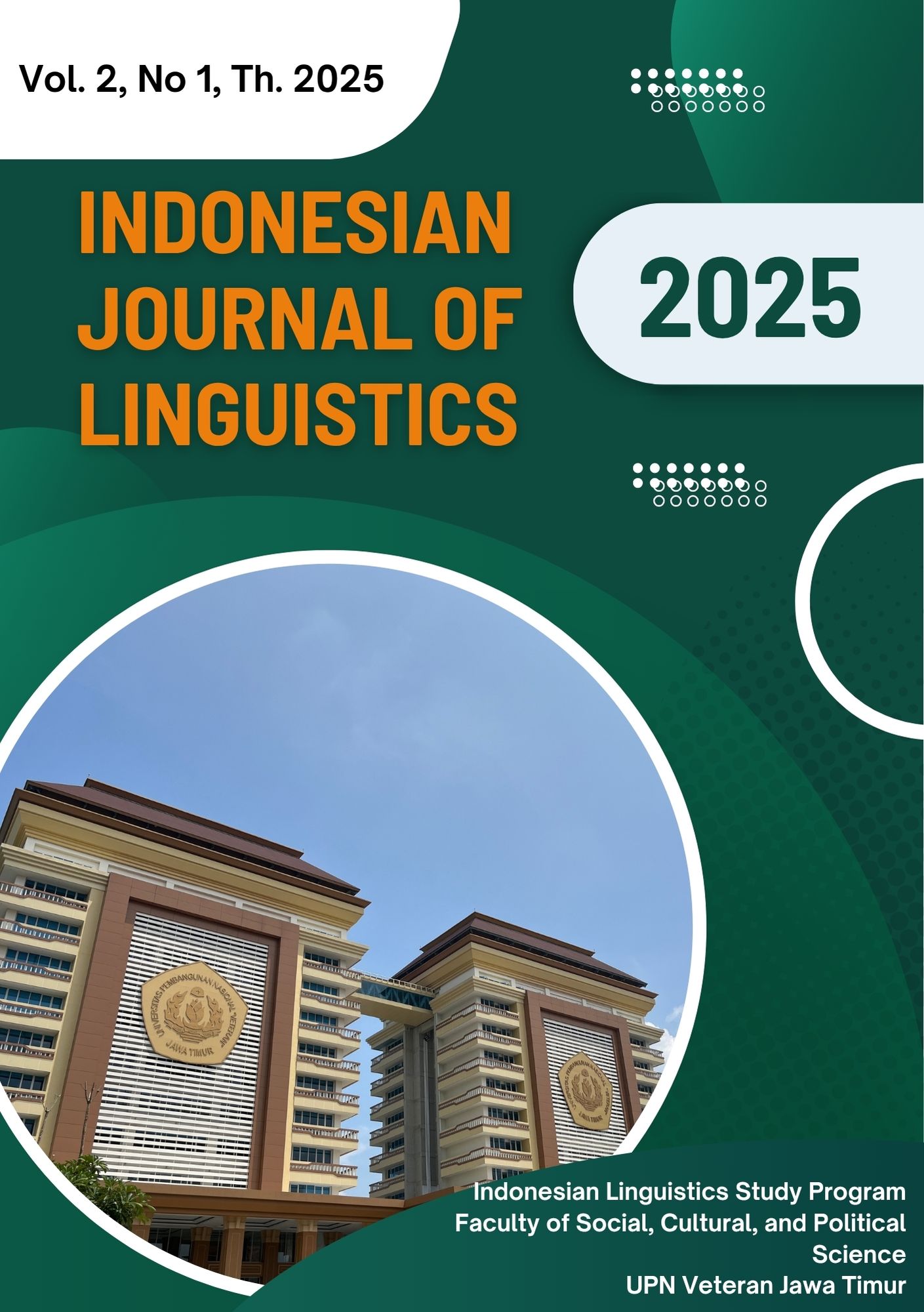Exploring Transitivity in Cinderella Story: Analyzing Participants, Processes, and Circumstances
DOI:
https://doi.org/10.33005/ijl.v2i1.25Keywords:
Systemic Functional Linguistics (SFL), Transitivity system, Narrative textsAbstract
Using the framework of Systemic Functional Linguistics (SFL), this study investigates the transitivity system in narrative texts with a particular focus on Cinderella Story. Collaborating participants, processes, and circumstances in language to communicate meaning is transitivity. The study explores how actors, aims, and sayers build the story along with material, mental, and relational processes emphasizing actions, emotions, and relationships. Time, location, and cause are circumstantial components that improve the story and bring the reader to significant moments. According to the research, circumstantial components of time and place create the story's unknown and timeless state of mind, but material processes survive and reflect the action-driven nature of the narrative. Participants emphasize the relationships between power and character transformation, such as Cinderella as the actor and the Prince as both actor and objective. In addition to creating the narrative, these linguistic components reflect latent ideas, cultural norms, and societal values. The theoretical and educational consequences of transitivity analysis are emphasized in this article. Demonstrating how narratives create meaning improves linguistic theory and provides educators useful tools to enhance their students' critical text comprehension. This study shows how transitivity in educational methods can foster greater engagement with stories and an understanding of their underlying social and cultural elements.
References
Alharbi, A. (2021). Controversy and discourse: The arts of transforming negativity through transitivity. SAGE Open, 11(4), 21582440211066896. https://doi.org/10.1177/21582440211066896
Fauzi, S., Thohir, L., Zamzam, A., & Melani, B. Z. (2024, March). English department students wrote an analysis of the transitivity system. Journal of English Education Forum (JEEF, 4(1), 38–43. https://jeef.unram.ac.id/index.php/jeef/article/view/582
Halliday, M. A. K., & Matthiessen, C. M. I. M. (2014). Halliday's Introduction to Functional Grammar (4th ed.). Routledge. https://research.polyu.edu.hk/en/publications/hallidays-introduction-to-functional-grammar
Matthiessen, C. M. I. M. (2018). Transitivity in systemic functional linguistics: Achievements and challenges. In Estudos de transitividade em linguística sistêmico-funcional (pp. 14–108). PPGL Editores. https://repositorio.ufsm.br/bitstream/handle/1/18870/Livro%20SF1.pdf?sequence=1#page=14
Mulyanti, W., & Wati, S. (2022). Transitivity system in narrative texts for junior high school. Jurnal Pendidikan Edutama, 9(1), 133–146. https://www.researchgate.net/profile/Setyo-Wati/publication/376037450_TRANSITIVITY_SYSTEM_IN_NARRATIVE_TEXTS_FOR_JUNIOR_HIGH_SCHOOL/links/6567f90ab1398a779dc71064/TRANSITIVITY-SYSTEM-IN-NARRATIVE-TEXTS-FOR-JUNIOR-HIGH-SCHOOL.pdf
Rizkiani, F. (2023). The transitivity analysis of reading texts in the English textbook "English for Nusantara" used in Curriculum Merdeka (Doctoral dissertation, IAIN Ponorogo). http://etheses.iainponorogo.ac.id/24985/
Suparto, A. D. (2018). Transitivity analysis on framing in the online news articles. Ranah: Jurnal Kajian Bahasa, 7(1), 16–32. http://ojs.badanbahasa.kemdikbud.go.id/jurnal/index.php/jurnal_ranah/article/view/586
Toolan, M. (2016). Making sense of narrative text: Situation, repetition, and picturing in the reading of short stories. Routledge. https://www.taylorfrancis.com/books/mono/10.4324/9781315622965/making-sense-narrative-text-michael-toolan
Tsirogianni, S., & Sammut, G. (2014). Transitivity analysis: A framework for studying social values in the context of points of view. British Journal of Social Psychology, 53(3), 541–556. https://bpspsychub.onlinelibrary.wiley.com/doi/abs/10.1111/bjso.12047
Zein, T., Sinar, T., Nurlela, N., & Yusuf, M. (2019). The incomplete linguistic features and schematic structure in EFL university students' narrative texts. Journal of Education, Teaching and Learning, 4(1), 203–209. https://www.learntechlib.org/p/209130/
Harper, E. (2023). The hidden cave. Modern Tales for Young Readers. Bright Horizons Publishing.
Butt, D., Fahey, R., Feez, S., Spinks, S., & Yallop, C. (2000). Using functional grammar: An explorer’s guide. National Centre for English Teaching and Research. https://giadpatagonia.wordpress.com/wp-content/uploads/2016/06/butt-et-al-using-functional-grammar-2003.pdf
Downloads
Published
How to Cite
Issue
Section
License
Copyright (c) 2025 Indonesian Journal of Linguistics

This work is licensed under a Creative Commons Attribution-ShareAlike 4.0 International License.
Indonesian Journal of Linguistics by Universitas Pembangunan Nasional “Veteran” Jawa Timur is licensed under a Creative Commons Attribution-ShareAlike 4.0 International License.
1. The journal allows the author to hold the copyright of the article without restrictions.
2. The journal allows the author(s) to retain publishing rights without restrictions
3. The legal formal aspect of journal publication accessibility refers to Creative Commons Attribution Share-Alike (CC BY-SA).
4. The Creative Commons Attribution Share-Alike (CC BY-SA) license allows re-distribution and re-use of a licensed work on the conditions that the creator is appropriately credited and that any derivative work is made available under “the same, similar or a compatible license”. Other than the conditions mentioned above, the editorial board is not responsible for copyright violation.








